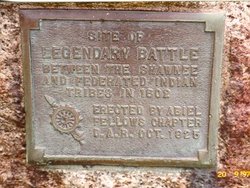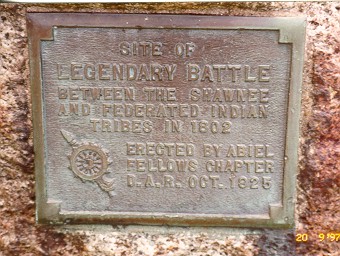Shawnee Indian Chief Elkhart and his tribe came into the Elkhart, Indiana area from Ohio about 1800, looking for a land with plenty of game, forests, grassy areas, and clear water. Conflicts developed as the Shawnee came into contact with the Ottawa and Potawatomi tribes, who were already here. The Pottawatomie long held possession. They lived in peace with their neighbors, the Ottawa's of the Kalamazoo Valley and with the most distant Ottawa's of the Grand River Valley.
In 1801, Under the leadership of Chief Elkhart, the Shawnee attacked the Pottawatomie tribe led by Chief Leopold Pokagon driving them from the St. Joseph Valley, Indiana to Michigan. They had crept through the wilderness and fell suddenly upon the unsuspecting Pottawatomie. In the surprise battle that followed, the Pottawatomie were defeated and driven from their homes. However, victory was costly to Chief Elkhart, for the vanquished Pottawatomie and Grey Wolfe, a Pottawatomie Indian, carried away with them, in their flight, Princess Mishawaka, daughter of the fierce Shawnee leader, Chief Elkhart. (Herewith, began the romance of the princess, a romance of St. Joseph County that was to separate her from her people but to bring her happiness with her scout lover. Princess Mishawaka stayed in the area and married the white trapper, Dead Shot who rescued her from the Pottawatomie.)
Chief Elkhart set up his village in the favorable spot where the Pottawatomie had their teepees - where the Rocky River, the Portage River and the St. Joseph River came together, the present site of Three Rivers. The oak openings, rivers, lakes and prairies of St. Joseph County and the hunting, the fishing and the crops they afforded were too dear to the Pottawatomie to be given up without a desperate struggle.
Chief Pokagon called into council of war the Ottawa's of the Kalamazoo Valley, under Chief Waukazoo, and the Ottawa's of the Grand River Valley, under Chief Okemos. Three bands decided to unite and drive out the invader. This they did, attacking from all sides by fleets of canoes and by land. The Shawnees had entrenched themselves and were ready to meet one band, but when two other bands made attacks from other directions the Shawnees were taken by surprise and routed. The Shawnee fled in panic. Later, old Chief Elkhart sued for peace, departing with his followers to the Valley of the Wabash, or Wabash Valley, from whence they had come.
The invasion was repelled by Chief Pokagon and his Pottowatomies, in a conflict centered in St. Joseph County. Chief Pokagon centered his forces north of Three Rivers, and Chief Elkhart's Shawnees had gained possession of the White Pigeon Prairie. Chief Elkhart attacked Chief Pokagon around April 1st close to the confluence of the three rivers.' The federated Indian tribes. The decisive battle between Chief Elkhart's Shawnees and the three confederate tribes of Michigan was fought around 1802 in two stages. The first half of the struggle for possession of the land occurred in the area now known as Scidmore Park. The last part of the battle was along the Portage and culminated where the power house now stands on its bank. Chief Elkhart occupied the Wabash valley in Indiana was aggressive and attempted to move into southwestern Michigan.
Read more about him: "Elkhart: A Pictorial History," written by George E. Riebs and published by G. Bradley Publishing, Inc., St. Louis, Missouri.
Shawnee Indian Chief Elkhart and his tribe came into the Elkhart, Indiana area from Ohio about 1800, looking for a land with plenty of game, forests, grassy areas, and clear water. Conflicts developed as the Shawnee came into contact with the Ottawa and Potawatomi tribes, who were already here. The Pottawatomie long held possession. They lived in peace with their neighbors, the Ottawa's of the Kalamazoo Valley and with the most distant Ottawa's of the Grand River Valley.
In 1801, Under the leadership of Chief Elkhart, the Shawnee attacked the Pottawatomie tribe led by Chief Leopold Pokagon driving them from the St. Joseph Valley, Indiana to Michigan. They had crept through the wilderness and fell suddenly upon the unsuspecting Pottawatomie. In the surprise battle that followed, the Pottawatomie were defeated and driven from their homes. However, victory was costly to Chief Elkhart, for the vanquished Pottawatomie and Grey Wolfe, a Pottawatomie Indian, carried away with them, in their flight, Princess Mishawaka, daughter of the fierce Shawnee leader, Chief Elkhart. (Herewith, began the romance of the princess, a romance of St. Joseph County that was to separate her from her people but to bring her happiness with her scout lover. Princess Mishawaka stayed in the area and married the white trapper, Dead Shot who rescued her from the Pottawatomie.)
Chief Elkhart set up his village in the favorable spot where the Pottawatomie had their teepees - where the Rocky River, the Portage River and the St. Joseph River came together, the present site of Three Rivers. The oak openings, rivers, lakes and prairies of St. Joseph County and the hunting, the fishing and the crops they afforded were too dear to the Pottawatomie to be given up without a desperate struggle.
Chief Pokagon called into council of war the Ottawa's of the Kalamazoo Valley, under Chief Waukazoo, and the Ottawa's of the Grand River Valley, under Chief Okemos. Three bands decided to unite and drive out the invader. This they did, attacking from all sides by fleets of canoes and by land. The Shawnees had entrenched themselves and were ready to meet one band, but when two other bands made attacks from other directions the Shawnees were taken by surprise and routed. The Shawnee fled in panic. Later, old Chief Elkhart sued for peace, departing with his followers to the Valley of the Wabash, or Wabash Valley, from whence they had come.
The invasion was repelled by Chief Pokagon and his Pottowatomies, in a conflict centered in St. Joseph County. Chief Pokagon centered his forces north of Three Rivers, and Chief Elkhart's Shawnees had gained possession of the White Pigeon Prairie. Chief Elkhart attacked Chief Pokagon around April 1st close to the confluence of the three rivers.' The federated Indian tribes. The decisive battle between Chief Elkhart's Shawnees and the three confederate tribes of Michigan was fought around 1802 in two stages. The first half of the struggle for possession of the land occurred in the area now known as Scidmore Park. The last part of the battle was along the Portage and culminated where the power house now stands on its bank. Chief Elkhart occupied the Wabash valley in Indiana was aggressive and attempted to move into southwestern Michigan.
Read more about him: "Elkhart: A Pictorial History," written by George E. Riebs and published by G. Bradley Publishing, Inc., St. Louis, Missouri.
Advertisement
Explore more
Sponsored by Ancestry
Advertisement


